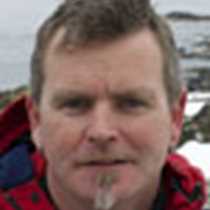Napier
Well they usually call Hawkes Bay ‘Sunny Hawkes Bay’, but unfortunately for us, this was not the case this morning. With a light drizzle falling, we boarded the busses to head out on our morning excursion, the Australasian gannet colony at Cape Kidnappers. This rather famous gannetry was for some time the only mainland gannet colony in the World. Due to the increase in numbers of the Northern gannet in the North Atlantic and the Australasian gannet here in New Zealand and Australia, there are now several mainland gannetries. But Cape Kidnappers is certainly a very special place, with incredible scenery and a real story to be told.
The peninsula takes its name from the kidnapping of Captain Cook’s Tahitian cabin boy by local Maori during one of his visits. They mistakenly thought he was a Maori boy, and so took him in an effort to rescue him, however, he managed to escape and get back to the ship. Since then this area has been heavily modified and colonised by European settlers, who set up large sheep and cattle stations in the area. The Cape Kidnappers Station is now owned by American Billionaire Julian Robertson, and he has built an exquisite 18-hole golf course and lodge, but still operates the area as a working farm. Moreover, neighbouring landowner Andy Lowe initiated the creation of a large Wildlife Preserve that now encapsulates the Station and several neighbouring properties. The area has had a predator fence built, and encapsulates around 2,200 hectares (5400 acres) of farmland, pine forest, native forest and coastal dunes. Within the fenced area there is now a network of traps and bait stations to reduce introduced predators to low levels. As a consequence bird numbers are flourishing and several species, including Northern brown kiwi, brown teal, rifleman, whitehead, tomtit and North Island robin have now been reintroduced.
So as we drove out through the Station we passed through the fence, pausing to look at its construction, and then saw many of the trap boxes as we drove out towards the end of the Cape and gannetries. As there were two other large ships in Napier today, we headed to our own private little area at the Black Reef gannet colony. We enjoyed the scenic beauty of the area, and were able to get really close to the birds that nested up on top of the cliffs. There were many well developed gray chicks, many of which were within a week or so of leaving the nest. Once they do so, the majority fly across the Tasman Sea and spend the first 2-3 years of life at sea, off the eastern coast of Australia. They then head back to New Zealand, generally back to the colony they came from to set about finding a mate and a nest site, and generally start breeding at 3-5 years of age. Many of the adults were attending the colony, and with golden yellow heads and clean white and black contrasting plumage, they really are a beautiful seabird.
We enjoyed the spectacle, had a cup of tea and cake, and Brent talked through biology of the species. We then headed up to the Plateau colony to take a look at the birds there, before heading back through the Station. We made a brief photo stop at the cliff edge to observe the sedimentary layers which no longer lay horizontally but all slope down to the west, before getting back onto the main road and back to the ship for lunch.
After lunch many of us participated on the Art Deco town city tour, getting to see some of the iconic buildings built in 1931-32 after the powerful earthquake (7.8 Richter scale) on February 3, 1931. The quake levelled both cities of Napier and Hastings, with 256 people killed. Of course our minds were still with the people of Christchurch still struggling with the recent devastation, making the tour all the more poignant.
We explored several parts of the city, seeing the straight lines and ziggurats, zig-zags and sunbursts characteristic of this style of building. Luckily, many of the shop and building façades have been protected, due to the presence of mind of local residents, allowing us to enjoy what is one of the best examples of this style of architecture world-wide. Many of us also took the opportunity to spend time wandering the streets on our own and exploring the shops and cafes.
Back onboard for dinner, we then sailed just before midnight, heading north across Hawke Bay towards Gisborne.




